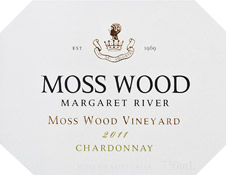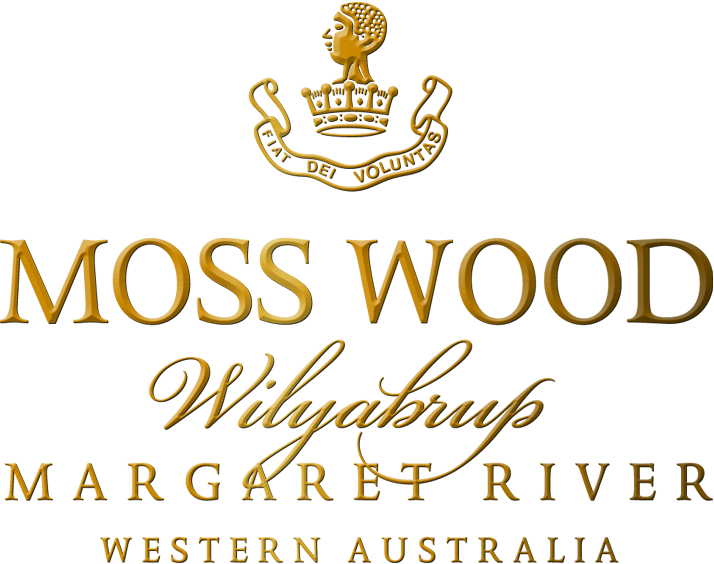Moss Wood 2011 Chardonnay

Wine Facts
| Harvested: | 18/2/2011 |
| Bottled: | 23/11/2012 |
| Released: | 5/9/2012 |
| Baume: | 13.00 |
| Alcohol: | 14.00% |
| Vintage Rating: | 10/10 |
SOLD OUT
Moss Wood 2011 Chardonnay – eRobertParker.com #208 Aug 2013 – Lisa Perrotti Brown MW
The 2011 Chardonnay possesses a lovely, tropical scented nose with notes of pink guava and pineapple over hints of butterscotch, cashews and honey-drizzled apricots plus a touch of toasty oak. Medium to full-bodied and richly fruited in the mouth, it has a silken texture and tons of tropical and stone…
“Chardonnay – The Chameleon of Grapes” – Moss Wood 2011 Chardonnay – Stephen Lau – Ming Pao News
Moss Wood is one of the first wineries in Margaret River. Keith and Clare Mugford owns the winery. The writer met Keith and Clare Mugford a few months ago in a wine tasting event and was impressed by theit enthusiastic and wholehearted involvement in running the winery. Moss Wood Cabernet…
Moss Wood 2011 Chardonnay – James Halliday – The Wine Companion
Whole bunch pressed, cold-settled in tank, then fermentation initiated with cultured yeast before transfer to French oak barriques and 30% taken through mlf; bottled in Sept after fining and filtration. A distinctly complex wine, mouthfilling and fleshy, white peach, fig and cashew to the fore, citrussy acidity on the finish,…
Moss Wood 2011 Chardonnay – Nick Stock, “Good Wine Guide 2013” goodfood.com.au
More traditional than some of Margaret River’s current chardonnays, this opens with toffee, melon, citrus and nutty barrel-fermented aromas of richness and substance. It tastes full and ripe with a smooth middle and a long, dry finish. Published: March 6, 2013
Moss Wood 2011 Chardonnay – Joondalup Weekender
We could say “rubbish” again or perhaps instead we could say, “Geez, have you tried this latest Moss Wood chardonnay?” The Mugfords, the Moss Wood winemakers and owners, believe this vintage is at least in their best few vintages to date, albeit of a significant change in style. This is…
Moss Wood 2011 Chardonnay – Josh Raynolds – New Best Wines from Australia
Bright yellow. Smoky, lees-accented aromas of pear skin, sweet butter, iodine and chamomile are lifted by a bright note of orange pith. Powerful and concentrated but lively, with a tactile quality to its sappy orchard fruit and brioche flavors. Very long and perfumed on a finish distinguished by notes of…
Moss Wood 2011 Chardonnay – Patrick Haddock – The Wining Pom
Finally. Moss Wood sort the oak out in their Chardonnay and I’m thrilled. In the past I’ve been a bit hard on previous vintages of this wine and its heavy handed use of oak that has made it look clumsy and fat. Not so in 2011. It’s still a big…
Moss Wood 2011 Chardonnay- Gary Walsh – The Wine Front
Have a swag of reviews for Moss Wood to publish including a surprisingly good 2009 Margaret River Pinot Noir, meanwhile here’s a Chardonnay that will find many admirers. Melon, creamy cashew and spice oak, some sweet lemon/lime and grapefruit. A little warm and glossy, and perhaps a little loose, but…
Moss Wood 2011 Chardonnay – Ralph Kyte-Powell, The Age
More traditional than some of Margaret River’s current chardonnays, this opens with toffee, melon, citrus and nutty barrel-fermented aromas of richness and substance. It tastes full and ripe with a smooth middle and a long dry finish.
Moss Wood 2011 Chardonnay – Subiaco Post
A brilliantly focused wine with citrus blossom and grapefruit along with lightly roasted cashew L and a shaking – of spice, harnessed together in a long, tight package. A few carefulty cellared years will see it break free of its shackles and show a wealth of complexity and great drinking…
Tasting Notes
Colour and condition: Medium straw hue; bright condition.
Nose: A lifted and complex nose showing the full array of Chardonnay aromas – nectarine, blossoms, marmalade and limes. The complexity derived from long term barrel aging adds malt, roast nut, toast and cinnamon notes.
Palate: The initial impact is of generous ripe fruits, full body and smooth texture. There are generous peach, marmalade and roast almond flavours, sitting over a balanced astringency that builds the mouthfeel but doesn’t impinge on the texture, so gives the wine a long, sweet, round feel.
Vintage Notes
Any discussion about the 2011 vintage must begin with a simple observation – it’s very unlikely we’ve had a better one. Somehow the planets aligned to give us that rare combination of warm, dry conditions when we needed them but regular rainfall to keep the soil moisture topped up. Flowering for most varieties, but especially Chardonnay, took place in excellent conditions and virtually no rain fell during those 3 weeks. Then it seemed like someone flicked a switch and we received several days of good rainfall before fine conditions returned for the next variety to flower. As farmers, we’ll happily take them again whenever Mother Nature feels inclined to do so.
A further advantage was we were able to run a consistent fungicide program because the weather tended not to interrupt the spraying cycle, meaning our disease control was better and cheaper. After all this good news, it’s hard to imagine that things could have been any better, but they were, because at the same time, we also avoided any hail damage and the birds didn’t bother us!
In spite of all this good news about quantity, we still have the most important issue to consider – quality. We can report that after such a good build up, the 2011 sits at or near the top of our quality tree but it’s worth considering this in the overall context of our 31 years of Chardonnay production.
Readers familiar with Moss Wood Chardonnay will know the style has varied during that time, as we experimented with variations in production techniques. It’s interesting to examine the averages of some the key wine components, namely harvest date, yield and ripeness, as they were in the decades that followed the first vintage in 1980.
From 1980 to 1989, the numbers were 26th February, 4.46 tonnes per hectare and 12.7⁰ Baume.
From 1990 to 1999, the numbers were 6th March, 8.35 tonnes per hectare and 13.4⁰ Baume.
From 2000 to 2009, the numbers were 27th February, 6.49 tonnes per hectare and 13.3⁰ Baume.
From 2010 to 2012, the numbers were 24th February, 9.81 tonnes per hectare and 13.1⁰ Baume.
This simple analysis shows some interesting things. In our first decade, we were making wines in a leaner style, with less ripeness and correspondingly lower alcohol, and with fruit characters leaning towards the citrus notes of grapefruit and lime. At the same time, the vineyard was cropping at lower yield, due in part to young vines and also our inexperience with handling the early budburst associated with our maritime climate and the problems that arose from the damage caused by Wilyabrup’s frequently stormy weather at that time of year.
The second decade the increase in yield suggests we learnt better management techniques to reduce the impact of the above. It also shows the harvest ripeness went up, as we began to prefer a wine style that displayed riper fruit characters. In real terms, this meant Moss Wood Chardonnay from the period showed a predominance of yellow-flesh stone fruits and marmalade. The third decade continued the theme, although towards the end of the period we started to pick at slightly lower ripeness to improve the freshness of the wine by retaining more of the greener notes, albeit only a small adjustment. Curious readers may have noted that our yields fell, especially during the middle years of the 2000’s, so it seems we must have forgotten some of our lessons.
Into our fourth decade, we have continued the trend of lower ripeness and fortunately, turned the yield decline around. It seems we are finally beginning to understand the Moss Wood Chardonnay vineyard and what style it produces best. It didn’t take long did it?
As an aside, those with an eye to wider issues may note that overall, our first decade appears to have been slightly cooler. The vines ripened smaller crops more slowly, although some of this change may be that in the decades since, ripening rates went up partly as a result of trellis improvements. Our weather station only began collecting data in 1998, so we can’t confirm the actual temperatures experienced during that decade.
In our view, the great vintages of Moss Wood Chardonnay released so far are: 1980, 1983, 1984, 1985, 1990, 1992, 1996, 1999, 2002, 2005, 2009 and 2010. We will admit that our view of the four oldest wines is influenced by the fact they were made during very exciting times. The 1980 was perhaps the most exciting of all, being the first barrel fermented wine Moss Wood had produced. Every step in the process was an adventure and the quality was unexpectedly good. The next three were just as interesting as we worked hard to understand good Chardonnay techniques and especially those used by the Burgundians. This meant we tried steps like extended lees contact and malolactic fermentation for the first time and were intrigued by the possibilities these offered. However, all things considered, these wines deserve their place on the list and especially the 1984 which is a personal favourite of Keith’s. Sadly it was such a tiny quantity that very few people had the chance to taste it.
What conclusions can we draw about the 2011 vintage? The yields and ripeness place it alongside some very fine years – 1996, 2005 and 2010. In our view, it has brighter fruit aromas than the ‘05 but still has that vintage’s complexity. It is generally more concentrated than the ‘96 and has better balanced tannins. Finally, it was picked very slightly less ripe than the 2010 and so while it is very similar, a case can be made that the 2011 is more lifted with its primary fruit aromas.
On balance, it ranks with the best Chardonnay wines we have made.
Production Notes
Median Harvest Date: 18th February, 2011
Harvest Ripeness: 13.0⁰ Baume
All the fruit was hand-picked and delivered to the winery for whole bunch pressing. The free run juice and pressings components were kept separate and both batches were cold settled in stainless steel tanks. The pressing were fined to remove excess phenolics. After cold settling the clear juice from both fractions was racked to stainless steel tanks and fermentation was initiated with pure yeast culture. After 24 hours, the process was properly under way and so the fermenting juice was racked to French oak barrels where it stayed until the ferment reached dryness. The barrels were all racked to stainless steel tank to equalise the blend and then it was racked back to oak.
Each barrel was seeded for malolactic fermentation and this was allowed to proceed to 30% completion. After this, all the barrels were racked and combined in stainless steel; the final blend was adjusted and then returned to oak.
The barrel aging continued until July 2012, when all the barrels were again racked and blended in stainless steel. Fining trials were carried out and the wine was treated with bentonite for protein stability and isinglass, for tannin balance.
Finally, on 5th September 2012, the wine was sterile filtered and bottled.
Cellaring Notes
In the mould of the best Moss Wood Chardonnays, we recommend this wine for long term cellaring. It will take around 10 years to develop the typical secondary notes of toast, caramel and butter and should reach a peak between 15 and 20 years of age.
